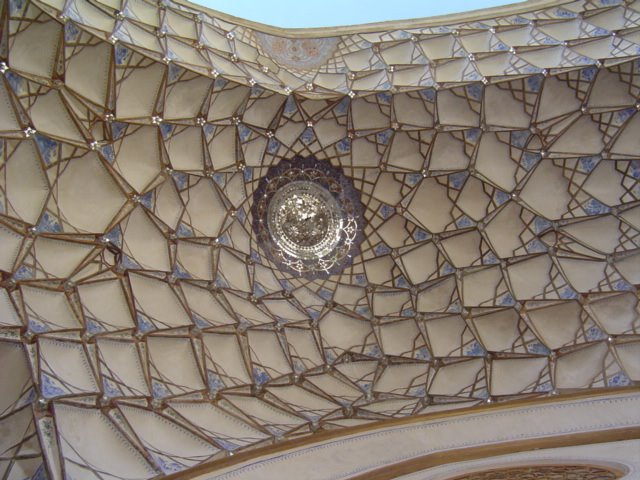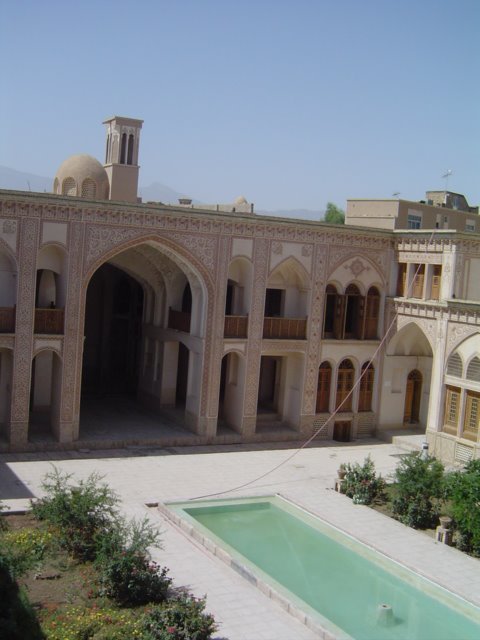سفرنامه کاشان
شهریور 1384
August 2004
 Old Houses of Kashan: Inside, Tabatabeai House
Old Houses of Kashan: Inside, Tabatabeai House
داخل خانه های قدیمی کاشان، خانه طباطبایی ها
August 2004
According to Wikipedia:
Kashan is a city in the province of Isfahan, Iran. It had an estimated population of 272,359 in 2005. The etymology of the city name comes from the Persian word Kashi, which translates into the English word tile. Kashan is the first of the large oases along the Qom-Kerman road which runs along the edge of the central deserts of Iran. Its charm is thus mainly due to the contrast between the parched immensities of the deserts and the greenery of the well-tended oasis.
Archeological discoveries in the Sialk Hillocks which lie 2.5 miles (4 km) west of Kashan reveal that this region was one of the primary centers of civilization in pre-historic ages. Hence Kashan dates back to the Elamite period of Iran. The Sialk ziggurat still stands today in the suburbs of Kashan after 7000 years.
Kashan is a city in the province of Isfahan, Iran. It had an estimated population of 272,359 in 2005. The etymology of the city name comes from the Persian word Kashi, which translates into the English word tile. Kashan is the first of the large oases along the Qom-Kerman road which runs along the edge of the central deserts of Iran. Its charm is thus mainly due to the contrast between the parched immensities of the deserts and the greenery of the well-tended oasis.
Archeological discoveries in the Sialk Hillocks which lie 2.5 miles (4 km) west of Kashan reveal that this region was one of the primary centers of civilization in pre-historic ages. Hence Kashan dates back to the Elamite period of Iran. The Sialk ziggurat still stands today in the suburbs of Kashan after 7000 years.
 Old Houses of Kashan: Inside, Tabatabeai House
Old Houses of Kashan: Inside, Tabatabeai Houseداخل خانه های قدیمی کاشان، خانه طباطبایی ها
حیاط خانه های قدیمی کاشان، خانه طباطبایی ها
 Old Houses of Kashan: Outward Walls, Tabatabeai House
Old Houses of Kashan: Outward Walls, Tabatabeai Houseدیوارهای خارجی خانه های قدیمی کاشان، خانه طباطبایی ها
حیاط خانه های قدیمی کاشان، خانه طباطبایی ها
 Old Houses of Kashan: Front Yard, Tabatabeai House
Old Houses of Kashan: Front Yard, Tabatabeai Houseحیاط خانه های قدیمی کاشان، خانه طباطبایی ها
 Old Houses of Kashan: Front Yard, Tabatabeai House
Old Houses of Kashan: Front Yard, Tabatabeai Houseحیاط خانه های قدیمی کاشان، خانه طباطبایی ها
 An Old Public Bath, Sultan Amir Bath
An Old Public Bath, Sultan Amir Bathحمام قدیمی، حمام سلطان امیر
 An Old Public Bath, Sultan Amir Bath
An Old Public Bath, Sultan Amir Bathحمام قدیمی، حمام سلطان امیر
 An Old Public Bath, Sultan Amir Bath
An Old Public Bath, Sultan Amir Bathحمام قدیمی، حمام سلطان امیر
 An Old Public Bath, Sultan Amir Bath
An Old Public Bath, Sultan Amir Bathحمام قدیمی، حمام سلطان امیر
 Old Houses of Kashan: Ceiling, Amerian House
Old Houses of Kashan: Ceiling, Amerian Houseسقف خانه های قدیمی کاشان، خانه عامری ها
 Old Houses of Kashan: Front Yard, Amerian House
Old Houses of Kashan: Front Yard, Amerian Houseحیاط خانه های قدیمی کاشان، خانه عامری ها
 Old Houses of Kashan: Underground Place, Amerian House
Old Houses of Kashan: Underground Place, Amerian Houseاندرونی زیرزمین خانه های قدیمی کاشان، خانه عامری ها
 Old Houses of Kashan: Front Yard, Amerian House
Old Houses of Kashan: Front Yard, Amerian Houseحیاط خانه های قدیمی کاشان
 Old Houses of Kashan: Ceiling, Amerian House
Old Houses of Kashan: Ceiling, Amerian Houseسقف خانه های قدیمی کاشان، خانه عامری ها
 Old Houses of Kashan: Inside, Amerian House
Old Houses of Kashan: Inside, Amerian Houseداخل خانه های قدیمی کاشان، خانه عامری ها
 Old Houses of Kashan: Front Yard, Amerian House
Old Houses of Kashan: Front Yard, Amerian Houseحیاط خانه های قدیمی کاشان، خانه عامری ها
 Old Houses of Kashan: Front Yard, Amerian House
Old Houses of Kashan: Front Yard, Amerian Houseحیاط خانه های قدیمی کاشان، خانه عامری ها
 Old Houses of Kashan: Front Yard, Amerian House
Old Houses of Kashan: Front Yard, Amerian Houseحیاط خانه های قدیمی کاشان، خانه عامری ها
 Gate of An Old House, Amerian House
Gate of An Old House, Amerian Houseدروازه ورودی یکی از خانه های قدیمی کاشان، خانه عامری ها
According to Wikipedia:
Fin Garden, or Bagh-e Fin, located in Kashan, Iran, is a historical Persian garden. It contains Kashan's Fin Bath. The origins of the garden may be anterior to the Safavid period, some sources indicate that the garden has been relocated from another place, but no clear picture of it has been found. The settlements of the garden in its present form was built under the reign of Abbas I of Persia (1571-1629).
On 2007, 8 September, Fin Garden has been submitted to the Unesco's World Heritage List.
The garden covers 2.3 hectares with a main yard surrounded by ramparts with four circular towers. In keeping with many of the Persian gardens of this era, the Fin Garden employs a great many water features. These were fed from a spring on a hillside behind the garden, and the water pressure was such that a large number of circulating pools and fountains could be constructed without the need for mechanical pumps. The garden contains numerous cypress trees and combines architectural features of the Safavid, Zandiyeh and Qajar periods.
On 2007, 8 September, Fin Garden has been submitted to the Unesco's World Heritage List.
The garden covers 2.3 hectares with a main yard surrounded by ramparts with four circular towers. In keeping with many of the Persian gardens of this era, the Fin Garden employs a great many water features. These were fed from a spring on a hillside behind the garden, and the water pressure was such that a large number of circulating pools and fountains could be constructed without the need for mechanical pumps. The garden contains numerous cypress trees and combines architectural features of the Safavid, Zandiyeh and Qajar periods.
 Fin Garden
Fin Gardenباغ فین
 Fin Garden
Fin Gardenباغ فین
 Fin Garden
Fin Gardenباغ فین
 Fin Garden
Fin Gardenباغ فین
 Niassar Waterfall
Niassar Waterfallآبشار نیاسر
 Niassar Waterfall
Niassar Waterfallآبشار نیاسر
According to Wikipedia:
Abyaneh is a famous historic Iranian village near the city of Kashan in Isfahan Province. With a unique reddish hue, the village is one of the oldest in Iran, attracting numerous native and foreign tourists year-round, especially during traditional feasts and ceremonies.
Abyaneh has been called an entrance to Iranian history. The local clothing, for example, is in a style of great antiquity. An Abyunaki woman typically wears a white long scarf (covering the shoulders and upper trunk) which has a colourful pattern and an under-knee skirt. Even the most immediate villages' women have different dress style so that one could tell if she is from Abyaneh or not. They have persistently maintained this traditional costume despite pressures from time to time by the government trying to change it.
On top of the village sits the ruins of a Sassanid era fort. Since June 2005, the village has been undergoing archaeological excavations for the first time ever, as a result of an agreement between Abyaneh Research Center and the Archaeology Research Center of the Iranian Cultural Heritage and Tourism Organization (ICHTO).
 Historical Village of Abyaneh
Historical Village of Abyanehروستای تاریخی ابیانه
 Historical Village of Abyaneh
Historical Village of Abyanehروستای تاریخی ابیانه
 Historical Village of Abyaneh
Historical Village of Abyanehروستای تاریخی ابیانه
According to Wikipedia:
Sohrab Sepehri (October 7, 1928 - April 21, 1980) was a notable modern Persian poet and a painter.
He was born in Kashan in Isfahan province. He is considered one of the five most famous modern Persian (Iranian) poets who have practiced "New Poetry" (a kind of poetry that often has neither meter nor rhyme). Sohrab Sepehri was also one of Iran's foremost modernist painters.
Sepehri died in Pars hospital in Tehran of leukemia. His poetry is full of humanity and concern for human values. He loved nature and refers to it frequently. The poetry of Sohrab Sepehri bears great semblance to that of E.E. Cummings.
Well-versed in Buddhism, mysticism and western traditions, he mingled the western concepts with eastern ones, thereby creating a kind of poetry unsurpassed in the history of Persian literature. To him, new forms are new means to express his thoughts and feelings. His poetry is, indeed, like a journey. Every time you read him you understand him differently. There is a bottomless ocean of meanings in his poetry. His poetry has been translated into many languages including French, English, Spanish, Italian, Swedish and Russian.
سنگ قبر سهراب سپهریSohrab Sepehri (October 7, 1928 - April 21, 1980) was a notable modern Persian poet and a painter.
He was born in Kashan in Isfahan province. He is considered one of the five most famous modern Persian (Iranian) poets who have practiced "New Poetry" (a kind of poetry that often has neither meter nor rhyme). Sohrab Sepehri was also one of Iran's foremost modernist painters.
Sepehri died in Pars hospital in Tehran of leukemia. His poetry is full of humanity and concern for human values. He loved nature and refers to it frequently. The poetry of Sohrab Sepehri bears great semblance to that of E.E. Cummings.
Well-versed in Buddhism, mysticism and western traditions, he mingled the western concepts with eastern ones, thereby creating a kind of poetry unsurpassed in the history of Persian literature. To him, new forms are new means to express his thoughts and feelings. His poetry is, indeed, like a journey. Every time you read him you understand him differently. There is a bottomless ocean of meanings in his poetry. His poetry has been translated into many languages including French, English, Spanish, Italian, Swedish and Russian.








